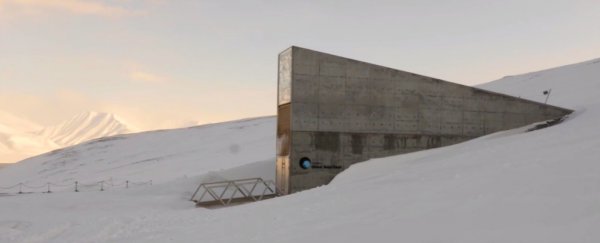Just a few kilometres shy of the North Pole, on the Arctic island of Svalbard, there's a doorway leading into the side of a frozen mountain. Inside, stored deep within the permafrost, lies humanity's best chance of feeding ourselves in a distant, disaster-filled future.
Welcome to the Svalbard seed vault, also known as the 'doomsday vault', home to millions of seeds from around the planet. It's one of the most isolated places in the world for good reason, but in this episode of Veritasium, Derek takes us on a rare tour of the icy space.
The goal of the Svalbard Seed Vault is pretty simple - to keep the vast range of plants on Earth safe in case anything happens in the future. Despite the doomsday nickname, that 'something' doesn't necessarily have to be a global disaster - it could be anything from climate change to drought that leaves certain parts of society without the means to feed themselves.
Just last year, the first withdrawal ever was made by researchers in Syria after their seedbank in Aleppo was destroyed by bombing. Those seeds have since been sent to Morocco and Lebanon, where they'll be planted and used to research how to grow crops in the arid region.
But what does this vault look like? And how do we know our seeds will be protected there? As Derek explains, the Svalbard vault has been built within the permafrost of the Arctic so that it'll stay at a frosty temperature of around –5 degrees Celsius for 200 years, even without electricity. Right now it's maintained at –18 degrees Celsius.
It can withstand earthquakes, volcanic eruptions, nuclear meltdowns, and its position on the mountain means that it'll always be above sea level, even if all the ice on Earth melted (although it's safe to say if that happens we're going to have bigger issues than which crops to plant).
One you get inside, the series of long, frozen tunnels look kinda like something out of an apocalyptic video game - the whole place is pretty much deserted except for long stacks of seed-containing boxes, including some retro hand-made wooden ones from North Korea.
One of the coolest parts about the vault is that, although it's run like a bank - with no one but the depositor allowed to access or withdraw their seeds - all of its contents are publicly available to peruse online via a database.
So what are some of the strange things that are stored in there - and, more interestingly - what have the vault keepers had to knock back? Check out the video above to find out, and let's just say we're more than a little curious to look up what Kim Jong-Un has checked in.
